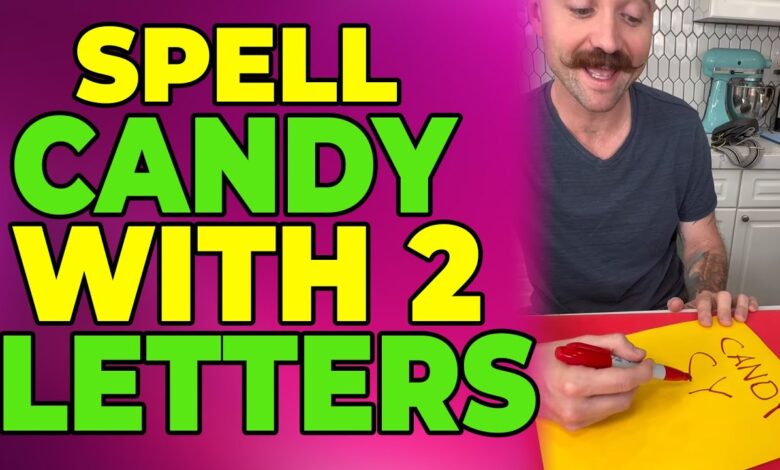Spell Candy with Two Letters: A Creative Exploration

When we think of the word “candy,” a multitude of images often come to mind—bright, colorful wrappers, sugary treats that are both sweet and enticing, and childhood memories of indulging in small, sugary morsels. But what if you were tasked with spelling “candy” using just two letters? This simple question can lead to an interesting exploration of language, symbols, and the playful nature of words. In this article, we’ll dive into what it means to “spell candy with two letters,” exploring different angles from linguistic perspectives to creative interpretations.
Understanding the Concept of Spelling
To start, it’s important to consider the basic concept of spelling. Traditionally, spelling is the act of arranging letters in a specific order to form a word. In the English language, spelling is largely governed by the rules of phonetics and grammar. For instance, the word “candy” is spelled with five letters: C, A, N, D, and Y. So, the question of spelling “candy” with only two letters may seem contradictory at first glance. After all, how can a word traditionally made up of five distinct characters be reduced to just two?
The answer lies in creativity, abstraction, and the ways language can be manipulated to take on new forms. In certain contexts, it’s possible to convey the spell candy with two letters essence or even a representation of the word “candy” without using the full five letters.
Symbolism and Representation
One way to approach the challenge of spelling “candy” with two letters is to think about symbolic representations. Words often carry a deeper meaning or evoke associations that go beyond their literal spelling. For example, if you were to choose two letters that represent “candy,” you might focus on the letters “C” and “Y.”
- C stands for the first letter of “candy,” and it could be viewed as representing sweetness or something enticing, as the sound of the “C” at the start of the word brings to mind the shape of a candy wrapper or the familiar sound of the word itself.
- Y is a letter that often symbolizes something mysterious or unknown, adding an element of playful intrigue. The “Y” in “candy” could be interpreted as the last letter, tying the symbol back to the full concept of sweetness and delight, or representing the final piece in a treat you can indulge in.
These two letters, “C” and “Y,” could serve as a minimalist representation of “candy” as a whole, evoking the essence of the word even though the complete spelling isn’t present. This is an example of how abstract thinking can lead to new ways of conveying meaning.
Phonetic Interpretation
Another angle to explore when discussing how to spell “candy” with two letters is through phonetic representation. Phonetics is the study of the sounds in speech, and sometimes words can be spelled out phonetically using fewer letters while still conveying the same sound. If we focus on how the word “candy” is pronounced, we might come up with a way to use just two letters that approximate the pronunciation.
For instance, the letters “K” and “D” could be used to symbolize the sound of the word “candy.” The “K” would stand in for the “C” sound, which is often phonetically similar, while “D” could represent the “D” sound in the middle of the word. Although this is a significant simplification, it can still function as a shorthand for the word when viewed in a creative or informal context.
The beauty of phonetic interpretation is that it allows us to break down words into their basic sound components. By doing so, we can often communicate the essence of the word even with a limited number of letters. This is particularly useful in contexts like texting, informal writing, or branding, where brevity is key.
Abbreviation and Informal Language
In everyday language, we often abbreviate words or use shortened forms to convey meaning quickly and efficiently. The same principle can be applied when spelling “candy” with just two letters. While there’s no widely accepted abbreviation for the word “candy” using only two letters, in certain informal or playful contexts, someone might simply refer to candy as “C” and “Y,” using these letters to evoke the idea of candy without fully spelling it out.
For instance, imagine a scenario in which two friends are texting back and forth about their favorite sweets. One friend could send a message saying “C & Y?”—a shorthand for “Candy?” The two-letter abbreviation would quickly convey the message while maintaining the playful and casual tone of the conversation. Here, the combination of “C” and “Y” works as an abbreviation, making the word both functional and fun.
Abbreviation is common in digital communication, and it’s not uncommon to see words shortened into just a few characters to suit the medium. In a similar way, “candy” could be shortened to “C” and “Y” when communication is swift, and the full word isn’t necessary to convey meaning.
Creativity and Wordplay
Language is full of room for creative expression. Writers, poets, and artists often play with words to create new forms of meaning, interpretation, and even humor. The idea of spelling “candy” with two letters can be viewed as a form of wordplay, where the rules of conventional spelling are bent or broken to create something new.
In a playful context, a person might intentionally choose two letters to represent “candy” as a form of creative expression. For example, they might use “C” and “N” to focus on the two prominent sounds in the word—”C” for the initial sound and “N” for the central consonant. The resulting two-letter combination could serve as a personal or artistic take on the word, adding a layer of creative interpretation.
This type of wordplay often leads to a deeper appreciation for language as a flexible, evolving tool that can be shaped to fit the needs of the moment. By reducing “candy” to two letters, the act itself becomes a creative exercise, prompting us to spell candy with two letters think more deeply about what language means and how it can be reimagined.
Conclusion
In conclusion, spelling “candy” with two letters is an exercise in creativity, symbolism, and playful manipulation of language. While the traditional spelling of “candy” consists of five letters, reducing it to two—whether by using “C” and “Y,” phonetically approximating it with “K” and “D,” or creating an abbreviation—provides an interesting way to explore the nuances of communication. Language is not just about following strict rules; it’s also about expression, imagination, and the ways in which words can evolve and adapt to new situations. By thinking outside the box and embracing alternative methods of spelling, we can gain a deeper appreciation for the fluid nature of language.
